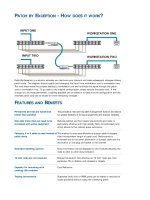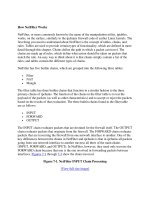Imagine how creativity works
Bạn đang xem bản rút gọn của tài liệu. Xem và tải ngay bản đầy đủ của tài liệu tại đây (1.58 MB, 568 trang )
Author of How We Decide
How Creativity Works
3/568
“Jonah Lehrer’s new book confirms what his
fans have known all along – that he knows
more about science than a lot of scientists
and more about writing than a lot of
writers.”
—Malcolm Gladwell
Did you know that the most creative com-
panies have centralized bathrooms? ?at
brainstorming meetings are a terrible idea?
?at the color blue can help you double your
creative output?
4/568
From the best-selling author of How We De-
cide comes a sparkling and revelatory look at
the new science of creativity. Shattering the
myth of muses, higher powers, even creat-
ive “types,” Jonah Lehrer demonstrates that
creativity is not a single gift possessed by the
lucky few. It’s a variety of distinct thought
processes that we can all learn to use more
effectively.
Lehrer reveals the importance of embracing
the rut, thinking like a child, and daydream-
ing productively, then he takes us out of our
own heads to show how we can make our
neighborhoods more vibrant, our companies
more productive, and our schools more
effective.
We’ll learn about Bob Dylan’s writing habits
and the drug addiction of poets. We’ll meet a
bartender who thinks like a chemist, and an
autistic surfer who invented an entirely new
surfing move. We’ll see why Elizabethan
5/568
England experienced a creative explosion,
and how Pixar designed its office space to get
the most out of its talent. Col apsing the lay-
ers separating the neuron from the finished
symphony, Imagine reveals the deep invent-
iveness of the human mind, and its essential
role in our increasingly complex world.
© 2012
Jonah Lehrer is a contributing editor at
Wired and a frequent contributor to The
New Yorker. He writes the Head Case
column for the Wall Street Journal and regu-
larly appears on WNYC’s Radiolab. His writ-
ing has also appeared in Nature, the New
York Times Magazine, Scientific American,
and Outside. The author of two previous
books, Proust Was a Neuroscientist and How
We Decide, he graduated from Columbia
University and attended Oxford as a Rhodes
scholar.
6/568
Cover illustration © Yulia Brodskaya • Cover
design by Martha Kennedy • Cover photo-
graphy by Michael Leznik Pre-pub media
event • Fifteen-city national author tour Na-
tional print and online advertising • Promo-
tional book trailer Author website: www.jo-
nahlehrer.com • On Twitter: @jonahlehrer,
or follow #Imagine
» Publication date: March 20, 2012 «
ISBN 978-0-547-38607-2 304 pages |
$26.00 | 5½ × 8¼ | Illustrations U N C O R
R E C T E D P R O O F
Jacket scans and press materials are avail-
able at www.hmhbooks.com.
ADVANCE UNCORRECTED PROOF
This copy is supplied for review purposes
only, and for limited distribution. As the
work is still under review by the author and
7/568
the publisher, there may be corrections, de-
letions, or other changes before publication.
Not for resale.
IMAGINE: How Creativity Works
Jonah Lehrer
Houghton Mifflin Harcourt
BOSTO N • NEW YORK
2012
Copyright © 2012 by Jonah Lehrer
All rights reserved
For information about permission to repro-
duce selections from this book, write to Per-
missions, Houghton Miffl in Harcourt Pub-
lishing Company, 215 Park Avenue South,
New York, New York 10003.
8/568
www.hmhbooks.com
9/568
CONTENTS
Introduction
ALONE
1. BOB DYLAN’S BRAIN
2. ALPHA WAVES (CONDITION
BLUE)
3. THE UNCONCEALING
4. THE LETTING GO
5. THE OUTSIDER
TOGETHER
6. THE POWER OF Q
7. URBAN FRICTION
8. THE SHAKESPEARE PARADOX
Coda
Notes
Acknowledgments
Index
11/568
Hell is a place where nothing
connects with nothing.
—T. S. Eliot, Introduction to Dante’s
Inferno
INTRODUCTION
Procter and Gamble had a problem: it
needed a new floor cleaner. In the 1980s, the
company had pioneered one lucrative con-
sumer product after another, from pull-up
diapers to anti-dandruff shampoo. It had
developed color-safe detergent and designed
a quilted paper towel that could absorb 85
percent more liquid than other paper towels.
These innovations weren’t lucky accidents:
Procter and Gamble was deeply invested in
research and development. At the time, the
corporation had more scientists on staff than
any other company in the world, more PhDs
than the faculties of MIT, UC-Berkeley, and
Harvard combined.
And yet, despite the best efforts of the chem-
ists in the household-cleaning division, there
were no new floor products in the pipeline.
The company was still selling the same
lemon-scented detergents and cloth mops;
consumers were still sweeping up their kit-
chens using wooden brooms and metal dust-
pans. The reason for this creative failure was
simple: it was extremely difficult to make a
stronger floor cleaner that didn’t also dam-
age the floor.
Although Procter and Gamble had invested
millions of dollars in a new generation of
soaps, these products tended to fail during
the rigorous testing phase, as they peeled off
wood varnishes and irritated delicate skin.
The chemists assumed that they had ex-
hausted the chemical possibilities.
That’s when Procter and Gamble decided to
try a new approach. The company out-
sourced its innovation needs to Continuum,
a design firm with offices in Boston and Los
Angeles.
14/568
“I think P and G came to us because their sci-
entists were telling them to give up,” says
Harry West, a leader on the soap team and
now Continuum’s CEO. “So they told us to
think crazy, to try to come up with
something that all those chemists couldn’t.”
But the Continuum designers didn’t begin
with molecules.
They didn’t spend time in the lab worrying
about the chemistry of soap. Instead, they
visited people’s homes and watched dozens
of them engage in the tedious ritual of floor
cleaning. The designers took detailed notes
on the vacuuming of carpets and the sweep-
ing of kitchens. When the notes weren’t
enough, they set up video cameras in living
rooms. “This is about the most boring foot-
age you can imagine,” West says. “It’s movies
of mopping, for God’s sake. And we had to
watch hundreds of hours of it.” The video-
tapes may have been tedious, but they were
also essential, since West and his team were
15/568
trying to observe the act of floor cleaning
without any preconceptions. “I wanted to
forget everything I knew about mops and
soaps and brooms,” he says. “I wanted to
look at the problem as if I’d just stepped off a
spaceship from Mars.”
After several months of observation — West
refers to this as the anthropologist phase —
the team members had their first insight. It
came as they watched a woman clean her
mop in the bathtub. “You’ve got this un-
wieldy pole,” West says. “And you are splash-
ing around this filthy water trying to get the
dirt out of a mop head that’s been expressly
designed to attract dirt. It’s an extraordinar-
ily unpleasant activity.” In fact, when the
Continuum team analyzed the videotapes,
they found that people spent more time
cleaning their mops than they did cleaning
the floors; the tool made the task more diffi-
cult. “Once I realized how bad mopping was,
I became quite passionate about floor
16/568
cleaning,” West says. “I became convinced
that the world didn’t need an improved ver-
sion of the mop. Instead, it needed a total re-
placement for the mop. It’s a hopeless piece
of technology.”
Unfortunately, the Continuum designers
couldn’t think of a better cleaning method. It
seemed like an impossible challenge. Per-
haps floor cleaning was destined to be an in-
efficient chore.
In desperation, the team returned to making
house visits, hoping for some errant inspira-
tion. One day, the designers were watching
an elderly woman sweep some coffee
grounds off the kitchen floor. She got out her
hand broom and carefully brushed the
grounds into a dustpan. But then something
interesting happened. After the woman was
done sweeping, she wet a paper towel and
wiped it over the linoleum, picking up the
last bits of spilled coffee. Although everyone
17/568
on the Continuum team had done the same
thing countless times before, this particular
piece of dirty paper led to a revelation.
What the designers saw in that paper towel
was the possibility of a disposable cleaning
surface. “All of a sudden, we realized what
needed to be done,” says Don Buchner, a
Continuum vice president. “We needed to in-
vent a spot cleaner that people could just
throw away. No more cleaning mop heads,
no more bending over in the bathtub, no
more buckets of dirty water. That was our
big idea.” A few weeks later, this epiphany
gave rise to their first floor-cleaning proto-
type. It was a simple thing, just a slender
plastic stick connected to a flat rectangle of
Velcro to which disposable pieces of electro-
static tissue were attached. A spray mechan-
ism was built into the device, allowing people
to wet the floor with a mild soap before they
applied the wipes. (The soap was mostly un-
necessary, but it smelled nice.) “You know an
18/568
idea has promise when it seems obvious in
retrospect,” West says. “Why splash around
dirty water when you can just wipe up the
dirt?
And why would you bother to clean this sur-
face? Why not just throw it away, like a used
paper towel?”
Procter and Gamble, however, wasn’t thrilled
with the concept. The company had de-
veloped a billion-dollar market selling con-
sumers the latest mops and soaps. They
didn’t want to replace that business with an
untested cleaning product. The first focus
groups only reinforced the skepticism. When
Procter and Gamble presented consumers
with a sketch of the new cleaning device, the
vast majority of people rejected the concept.
They didn’t want to throw out their mops or
have to rely on a tool that was little more
than a tissue on a stick. They didn’t like the
idea of disposable wipes, and they didn’t
19/568
understand how all that dirt would get onto
the moistened piece of paper. And so the
idea was shelved; Procter and Gamble wasn’t
going to risk market share on a radical new
device that nobody wanted.
But the designers at Continuum refused to
give up — they were convinced they’d dis-
covered the mop of the future. After a year of
pleading, they persuaded Procter and
Gamble to let them show their prototype to a
focus group. Instead of just reading a de-
scription of the product, consumers could
now play with an “experiential model” clad
in roughly cut plastic. The prototype made
all the difference: people were now en-
thralled by the cleaning tool, which they
tested out on actual floors. In fact, the
product scored higher in focus-group ses-
sions than any other cleaning device Procter
and Gamble had ever tested. “It was off
the charts,” Buchner says. “The same people
who hated the idea when it was just an idea
20/568
now wanted to take the thing home with
them.” Furthermore, tests by Procter and
Gamble demonstrated that the new product
cleaned the floor far better than sponge
mops, string mops, or any other kinds of
mops. According to the corporate scientists,
the “tissue on a stick” was one of the most ef-
fective floor cleaners ever invented.
In 1997, nearly three years after West and his
designers began making their videotapes,
Procter and Gamble officially submitted an
application for a U.S. patent. In the early
spring of 1999, the new cleaning tool was in-
troduced in supermarkets across the coun-
try. The product was an instant success: by
the end of the year, it had generated more
than $500 million in sales. Numerous imit-
ators and spinoffs have since been intro-
duced, but the original device continues to
dominate the post-mop market, taking up an
ever greater share of the supermarket aisle.
Its name is the Swiffer.
21/568
The invention of the Swiffer is a tale of cre-
ativity. It’s the story of a few engineers com-
ing up with an entirely new cleaning tool
while watching someone sweep up some cof-
fee grounds. In that flash of thought, Harry
West and his team managed to think differ-
ently about something we all do every day.
They were able to see the world as it was — a
frustrating place filled with tedious chores —
and then envision the world as it might be if
only there were a better mop. That insight
changed floor cleaning forever.
This book is about how such moments hap-
pen. It is about our most important mental
talent: the ability to imagine what has never
existed. We take this talent for granted, but
our lives are defined by it. There is the pop
song on the radio and the gadget in your
pocket, the art on the wall and the air condi-
tioner in the window. There is the medicine
in the bathroom and the chair you are sitting
in and this book in your hand.
22/568
And yet, although we are always surrounded
by our creations, there is something pro-
foundly mysterious about the creative pro-
cess. For instance, why did Harry West come
up with the Swiffer concept after watching
that woman wipe the floor with the paper
towel? After all, he’d done it himself on nu-
merous occasions.
“I can’t begin to explain why the idea arrived
then,” he says. “I was too grateful to ask too
many questions.” The sheer secrecy of cre-
ativity — the difficulty in understanding how
it happens, even when it happens to us —
means that we often associate breakthroughs
with an external force. In fact, until the En-
lightenment, the imagination was entirely
synonymous with higher powers: being cre-
ative meant channeling the muses, giving
voice to the ingenious gods. (Inspiration,
after all, literally means “breathed upon.”)
Because people couldn’t understand creativ-
ity, they assumed that their best ideas came
23/568
from somewhere else. The imagination was
outsourced.
The deep mysteriousness of creativity also
intimidated scientists. It’s one thing to study
nerve-reaction times or the mechanics of
sight. But how does one measure the imagin-
ation? The daunting nature of the subject led
researchers to mostly neglect it; a recent sur-
vey of psychology papers published between
1950 and 2000 revealed that less than 1 per-
cent of them investigated aspects of the cre-
ative process. Even the evolution of this hu-
man talent was confounding. Most cognitive
skills have elaborate biological histories, so
their evolution can be traced over time. But
not creativity — the human imagination has
no clear precursors.
There is no ingenuity module that got en-
larged in the human cortex, or even a proto-
creative impulse evident in other primates.
24/568
Monkeys don’t paint; chimps don’t write
poems; and it’s the rare animal (like the New
Caledonian crow) that exhibits rudimentary
signs of problem solving. The birth of cre-
ativity, in other words, arrived like any in-
sight: out of nowhere.
This doesn’t mean, however, that the imagin-
ation can’t be rigorously studied. Until we
understand the set of mental events that give
rise to new thoughts, we will never under-
stand what makes us so special. That’s why
this book begins by returning us to the ma-
terial source of the imagination: the three
pounds of flesh inside the skull. William
James described the creative process as
a “seething cauldron of ideas, where
everything is fizzling and bob-bing about in a
state of bewildering activity.” For the first
time, we can see the cauldron itself, that
massive network of electrical cells that allow
individuals to form new connections
between old ideas. We can take snapshots of
25/568









